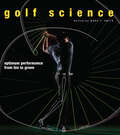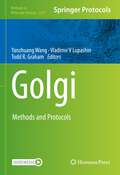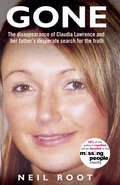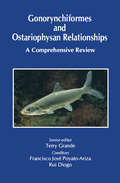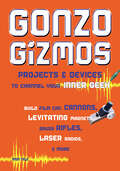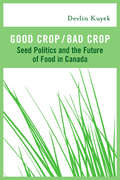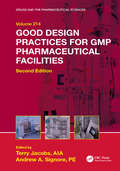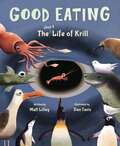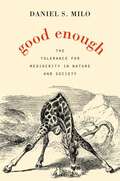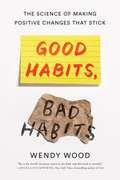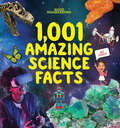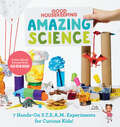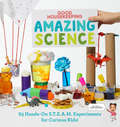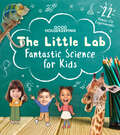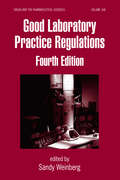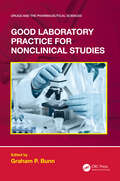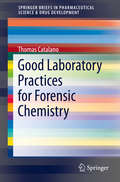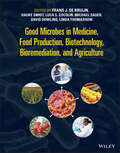- Table View
- List View
Golf Science: Optimum Performance from Tee to Green
by Mark F. SmithGolf is perhaps the most complicated simple game ever invented. Golfing greats like Jack Nicklaus and Tiger Woods make the sport look easy, but anyone who has ever picked up a club knows how truly frustrating golf can be. The success of each shot depends on a diverse range of factors, from the club you choose and the speed with which you swing it, to your mood, the weather, and even the type and cut of the grass. Science plays a crucial role in most, if not all, of these factors, and in Golf Science, sports science expert Mark F. Smith investigates the cutting-edge scientific wonders that take the ball from tee to hole. Each chapter explores a different facet of the game--mind and body, the swing, the equipment, the environment, coaching with technology, the practice process, and the score--and is organized around a series of questions. What happens in the brain during the preshot routine? Does head movement hinder swing performance? Will I hit the ball farther with a longer driver? Why do I lose distance into the wind? What can I learn from watching my ball in flight? How should practice be structured? What are the key stats in golf that I need to know? Each question is examined with the aid of explanatory diagrams and illustrations, and the book can be used to search for particular topics, or read straight through for a comprehensive overview of how golfer and equipment work together. A must-have for anyone who delights in the spirit of the game, Golf Science will be enjoyed not only by professionals and coaches but also by spectators of the PGA Tour and anyone who enjoys a round of eighteen holes on the weekend.
Golgi: Methods and Protocols (Methods in Molecular Biology #2557)
by Yanzhuang Wang Vladimir V Lupashin Todd R. GrahamThis volume provides readers with a collection of new and classical methods, techniques, and applications used to address enduring questions about the structure and functions of the Golgi complex. The chapters in this volume cover diverse topics ranging from model systems; live and fixed cell imaging techniques; in vitro biochemical reconstitution systems; and specific methods developed to study Golgi formation, maintenance, and functions under physiological and pathological conditions. Written in the highly successful Methods in Molecular Biology series format, chapters include introductions to their respective topics, lists of the necessary materials and reagents, step-by-step, readily reproducible laboratory protocols, and tips on troubleshooting and avoiding known pitfalls.Cutting-edge and authoritative, Golgi: Methods and Protocols is a valuable tool for researchers in the field who wish to explore new areas of Golgi biology and for new investigators interested in exploring Golgi structure and function.
Gone Dark
by Amanda PanitchDry meets Hatchet in this thrilling tale of survival following a teen girl who must lead her friends across the country to the safety of her estranged father&’s survivalist compound after a mass power failure leaves the country in chaos.When seventeen-year-old Zara escaped her father&’s backwoods survivalist compound five years ago, she traded crossbows and skinning hides for electricity and video games…and tried to forget the tragedy that drove her away. Until a malware attack on the United States electrical grids cuts off the entire country&’s power. In the wake of the disaster and the chaos that ensues, Zara is forced to call upon skills she thought she&’d never use again—and her best bet to survive is to go back to the home she left behind. Drawing upon a resilience she didn&’t know she had, Zara leads a growing group of friends on an epic journey across a crumbling country back to her father&’s compound, where their only hope for salvation lies. But with every step she takes, Zara wonders if she truly has what it takes to face her father and the secrets of her past, or if she&’d be better off hiding in the dark.
Gone: The Disappearance of Claudia Lawrence and Her Father's Desperate Search for the Truth
by Neil RootThe last time that anyone heard from 35-year-old Claudia Lawrence, a chef at the University of York, was when she sent a text message to a friend on 18 March 2009 at 8.23 p.m. She has never been heard from or seen again, and her disappearance is a mystery that endures to this day.What happened to Claudia that early spring evening – or was it early the following morning on her way to work? There had been nothing abnormal about her behaviour before she vanished, and there were no signs of a struggle at her home. A Crimewatch reconstruction has been broadcast, and the police investigation into the case has cost more than £750,000. Dozens of interviews have thrown up numerous leads, but there are no concrete clues.With extensive access to her family and friends, in Gone, Neil Root assesses the facts and theories and asks: where is Claudia?
Gonorynchiformes and Ostariophysan Relationships: A Comprehensive Review (Series on: Teleostean Fish Biology)
by Terry GrandeAn understanding of gonorynchiform morphology and systematic inter- and intra-relationships has proven vital to a better understanding of the evolution of lower teleosts in general, and more specifically of groups such as the clupeiforms (e.g., herrings and anchovies), and ostariophysans (e.g., carps, minnows and catfishes). This book examines the
Gonzo Gizmos: Projects & Devices to Channel Your Inner Geek
by Simon Quellen FieldStep-by-step instructions to building more than 30 fascinating devices are included in this book for workbench warriors and grown-up geeks. Detailed illustrations and diagrams explain how to construct a simple radio with a soldering iron, a few basic circuits, and three shiny pennies. Instructions are included for a rotary steam engine that requires a candle, a soda can, a length of copper tubing, and just 15 minutes. To use optics to roast a hot dog, no electricity or stove is required, just a flexible plastic mirror, a wooden box, a little algebra, and a sunny day. Also included are experiments most science teachers probably never demonstrated, such as magnets that levitate in midair, metals that melt in hot water, a Van de Graaff generator made from a pair of empty soda cans, and lasers that transmit radio signals. Every experiment is followed by an explanation of the applicable physics or chemistry.
Good Cook's Book of Oil and Vinegar: One of the World's Most Delicious Pairings, with more than 150 recipes
by M. F. K. Fisher Liza Gershman Michele Jordan"Michele Jordan knows her food and she knows how to write about it. ” --San Francisco Examiner What is extra virgin olive oil and how do you find the best kind? How do you cook with flavored vinegars and should they be bought or made at home? What are the best oils for frying? How does the strength of a vinegar influence a recipe? The Good Cook’s of Oil and Vinegar answers these and many other questions about this important culinary duo. The most comprehensive oil and vinegar guide available today, it offers key scientific, nutritional, and culinary facts as well as interesting history behind oil and vinegar. In addition, award-winning author Michele Anna Jordan shows how a distinctive oil or vinegar can add spark to a meal. She showcases a whole realm of delicious cooking with recipes such as: Bruschetta Fall fruit gazpacho Scallops primavera Roasted peppers balsamico Sicilian orange salad Apricot, persimmon, and cranberry chutneys Fruit, garlic, herb, ginger, and rose petal flavored vinegars And more
Good Crop / Bad Crop: Seed Politics and the Future of Food in Canada
by Devlin KuyekIN RECENT YEARS Canadians have become more and more concerned about the origins oftheir food and the environmental impacts of pesticides in agriculture. What is less well knownis that pesticide corporations such as Monsanto and Du Pont have bought their way into the seed industry and are taking control of what was once the exclusive domain of farmers.In Good Crop / Bad Crop, Devlin Kuyek deftly examines the economic and environmental background of the modern seed trade from a Canadian perspective. Historically seeds were viewed more as public goods than as commodities, and plant breeding objectives were widely shared by scientists, governments, and farmers. Now that approach is changing; seeds have become increasingly commodified, and plant breeding has become subject to corporate priorities. Farmers and citizens in Canada, Kuyek points out, need to heed the hard-won lessons from the developing world, where farmers greatly damaged by the much-heralded approaches of theGreen Revolution are now taking steps to reclaim control over seed supplies, food security, and their futures.
Good Design Practices for GMP Pharmaceutical Facilities (Drugs and the Pharmaceutical Sciences)
by Terry Jacobs Andrew A. SignoreThis revised publication serves as a handy and current reference for professionals engaged in planning, designing, building, validating and maintaining modern cGMP pharmaceutical manufacturing facilities in the U.S. and internationally. The new edition expands on facility planning, with a focus on the ever-growing need to modify existing legacy facilities, and on current trends in pharmaceutical manufacturing which include strategies for sustainability and LEED building ratings. All chapters have been re-examined with a fresh outlook on current good design practices.
Good Eating: The Short Life Of Krill
by Matt LilleyCalifornia Eureka Silver Honoree award 2022 "To my delight, your average krill is a far stranger story of metamorphosis than anything our butterflies can come up with." - Elizabeth Bird, A Fuse 8 Production A fun exploration of a tiny animal at the base of the ocean food chain Just 2 inches long full-grown, this little guy is the foundation of the Southern Ocean food chain... “Hi. What are you? You appear to be an egg. You are an egg sinking. For many days, you sink. You sink a mile down, and you keep sinking down… down… until…” The unidentified narrator follows one krill among billions as it pursues its brief existence, eating and eating while metamorphosing from one thing into another and trying to avoid being eaten. Questions and advice are hurled at the krill on every page, but the krill never responds—because, after all, krill can’t talk, and this is nonfiction. Krill are the largest animals able to catch and eat phytoplankton, and they in turn are eaten by the largest animals ever to live on earth—blue whales—as well as by seals, penguins, and a host of others. In other words, krill are really good at eating, and they make really good eating. And that makes them the most important animals in the high-latitude oceans. As in The Whale Fall Café, Dan Tavis’s illustrations combine scientific accuracy with Nemo liveliness and humor. Our star krill is so good at gobbling up phytoplankton that he turns green, so we can pick him out from the crowd racing to escape a penguin’s beak or a blue whale’s gaping maw. The book has been reviewed and endorsed by global krill expert Dr. Stephen Nichol, and the manuscript earned an honorable mention in Minnesota’s McKnight Artist Fellowships for Writers. Helpful backmatter is included. The Good Eating manuscript won an honorable mention in Minnesota’s McKnight Artist Fellowships for Writers. Technical review and endorsement from Dr. Stephen Nichol, adjunct professor at the University of Tasmania and author of The Curious Life of Krill.
Good Enough: The Tolerance for Mediocrity in Nature and Society
by Daniel S. MiloPhilosopher Daniel Milo offers a vigorous critique of the quasi-monopoly that Darwin’s natural selection has on our idea of the natural world. In popular thought, Darwinism has even acquired the trappings of an ethical system, focused on optimization, competition, and innovation. Yet in nature, imperfect creatures often have the evolutionary edge.
Good Germs, Bad Germs: Health And Survival In A Bacterial World
by Jessica Snyder SachsPublic sanitation and antibiotic drugs have brought about historic increases in the human life span; they have also unintentionally produced new health crises by disrupting the intimate, age-old balance between humans and the microorganisms that inhabit our bodies and our environment. As a result, antibiotic resistance now ranks among the gravest medical problems of modern times. Good Germs, Bad Germs tells the story of what went terribly wrong in our war on germs. It also offers a hopeful look into a future in which antibiotics will be designed and used more wisely, and beyond that to a day when we may replace antibacterial drugs and cleansers with bacterial ones.
Good Germs, Bad Germs: Health and Survival in a Bacterial World
by Jessica Snyder SachsMaking Peace with MicrobesPublic sanitation and antibiotic drugs have brought about historic increases in the human life span; they have also unintentionally produced new health crises by disrupting the intimate, age-old balance between humans and the microorganisms that inhabit our bodies and our environment. As a result, antibiotic resistance now ranks among the gravest medical problems of modern times. Good Germs, Bad Germs addresses not only this issue but also what has become known as the "hygiene hypothesis"— an argument that links the over-sanitation of modern life to now-epidemic increases in immune and other disorders. In telling the story of what went terribly wrong in our war on germs, Jessica Snyder Sachs explores our emerging understanding of the symbiotic relationship between the human body and its resident microbes—which outnumber its human cells by a factor of nine to one! The book also offers a hopeful look into a future in which antibiotics will be designed and used more wisely, and beyond that, to a day when we may replace antibacterial drugs and cleansers with bacterial ones—each custom-designed for maximum health benefits.
Good Habits, Bad Habits: The Science of Making Positive Changes That Stick
by Wendy WoodA landmark book about how we form habits, and what we can do with this knowledge to make positive changeWe spend a shocking 43 percent of our day doing things without thinking about them. That means that almost half of our actions aren’t conscious choices but the result of our non-conscious mind nudging our body to act along learned behaviors. How we respond to the people around us; the way we conduct ourselves in a meeting; what we buy; when and how we exercise, eat, and drink—a truly remarkable number of things we do every day, regardless of their complexity, operate outside of our awareness. We do them automatically. We do them by habit. And yet, whenever we want to change something about ourselves, we rely on willpower. We keep turning to our conscious selves, hoping that our determination and intention will be enough to effect positive change. And that is why almost all of us fail. But what if you could harness the extraordinary power of your unconscious mind, which already determines so much of what you do, to truly reach your goals?Wendy Wood draws on three decades of original research to explain the fascinating science of how we form habits, and offers the key to unlocking our habitual mind in order to make the changes we seek. A potent mix of neuroscience, case studies, and experiments conducted in her lab, Good Habits, Bad Habits is a comprehensive, accessible, and above all deeply practical book that will change the way you think about almost every aspect of your life. By explaining how our brains are wired to respond to rewards, receive cues from our surroundings, and shut down when faced with too much friction, Wood skillfully dissects habit formation, demonstrating how we can take advantage of this knowledge to form better habits. Her clear and incisive work shows why willpower alone is woefully inadequate when we’re working toward building the life we truly want, and offers real hope for those who want to make positive change.
Good Housekeeping 1,001 Amazing Science Facts
by Good Housekeeping Michael Burgan Rachel RothmanDo bees sleep? Can rocks bend? Discover the amazing answers to questions like these in this science fact-packed treasure trove for kids age 8 to 12!Join the experts at the Good Housekeeping Institute and get stoked about science! Discover incredible info about awesome animals, our exceptional planet Earth, exciting chemical reactions, extraordinary engineering, and more in this fun-filled, fact-packed book for budding scientists. Packed with hundreds of dynamite color photos and illustrations, hands-on STEAM activities, quizzes, and tons of cheeky jokes, this boredom-busting gift book provides young readers with a close-up look at the science all around us.Chapters cover super topics that kids love from animals to nature and Earth science to engineering and technology.Inside you&’ll find: Dig deep to explore Earth from the inside out, from what&’s going on deep below our feet, to why geysers erupt, and if we drink the same water as the dinosaurs did.Go inside the human body to learn how your eyes see, what happens to food after you eat it, and about the organ which is like a balloon.Investigate our natural world and find out if there are more trees or stars, how a coral reef grows from a tiny animal, and how freezing ice and fiery volcanoes are related.Travel back in time and check out why scientists study dinosaur poop. Then blast off into space to see how stars are born and innovations that will help people travel to Mars.Look at the animal kingdom, from your fellow primates like chimpanzees to insects with killer instincts (and you&’ll even get to find out which ones have the grossest gassy habits…ewww.) With the expert (and sometimes wacky!) science information kids crave, this ultimate book of answers is the perfect classroom resource or gift for the casual browser and the fact-obsessed budding young scientist.
Good Housekeeping Amazing Science Free S.T.E.A.M. Experiment Sampler
by Rachel RothmanTry 7 hands-on S.T.E.A.M. experiments in this special sampler from Good Housekeeping Amazing Science. You can make a vortex, investigate the forces that make an object sink or float and find out what happens when soap bubbles bump into one another!Inside, you&’ll find: • A color photograph for every experiment • Easy-to-follow instructions and a &“Mystery Solved&” explanation of the science at work • PLUS: incredible facts about water from Good Housekeeping lab experts Once you&’ve tried these experiments you&’ll want to get all 83 of them in Good Housekeeping Amazing Science! Bursting with more than 200 color photos and incredible facts, this is the ultimate book for your aspiring biologist, chemist, physicist, engineer, and mathematician. It&’s perfect for kids who are 7-years-old and older. Order now!
Good Housekeeping Amazing Science: 83 Hands-on S.T.E.A.M Experiments for Curious Kids!
by Good Housekeeping Aubre Andrus Rachel RothmanAwesome S.T.E.A.M.-based science experiments you can do right at home with easy-to-find materials designed for maximum enjoyment, learning, and discovery for kids ages 8 to 12Join the experts at the Good Housekeeping Institute Labs and explore the science you interact with every day. Using the scientific method, you&’ll tap into your own super-powers of logic and deduction to go on a science adventure. The engaging experiments exemplify core concepts and range from quick and simple to the more complex. Each one includes clear step-by-step instructions and color photos that demonstrate the process and end result. Plus, secondary experiments encourage young readers to build on what they&’ve discovered. A &“Mystery Solved!&” explanation of the science at work helps your budding scientist understand the outcomes of each experiment. These super-fun, hands-on experiments include: • Building a solar oven and making s&’mores • Creating an active rain cloud in a jar • Using static electricity created with a balloon to power a light bulb • Growing your own vegetables—from scraps! • Investigating the forces that make an object sink or float • And so much more! Bursting with more than 200 color photos and incredible facts, this sturdy hard cover is the perfect gift for any aspiring biologist, chemist, physicist, engineer, and mathematician!
Good Housekeeping The Little Lab: Fantastic Science for Kids
by Good Housekeeping Margie Markarian Rachel RothmanCurious readers ages 4 to 7 will go on a science adventure with 22 STEAM-based experiments and hundreds of incredible and fun scientific factsAttention all budding scientists: the Little Lab is open!Discover the wonders of science in exciting experiments that kids can do at home with easy-to-find materials. Whether they're blowing bubbles to spot rainbows, rubbing balloons to make static electricity, or launching pom-pom balls to understand the laws of motion, young scientists will be engrossed by memorable, hands-on, science and fun! Each experiment includes:Intros that preview the experiment and ask kids to make a prediction Eye-catching and helpful how-to photos Detailed supply list to streamline preparation Easy-to-follow steps that adults and kids can follow together What Happened? summaries to explain the science behind the fun in age-appropriate language The Little Lab puts STEAM in the spotlight with fun did-you-know facts and activities on every page! Plus, young readers will join the experts in the Good Housekeeping Institute as they share the secrets to thinking like a scientist. Are you ready to tap into your superpowers of logic and deduction? Let&’s go!
Good Laboratory Practice Regulations (Drugs and the Pharmaceutical Sciences)
by Sandy WeinbergRecent changes in the interpretation and enforcement of 21 CFR Part 11 have shifted the focus of Good Laboratory Practice (GLP) regulations to concentrate on the acceptance of electronic signatures, the archiving of data, the security of electronic documents, and the automation of laboratory procedures. This all-encompassing Fourth Edition addresse
Good Laboratory Practice for Nonclinical Studies (Drugs and the Pharmaceutical Sciences)
by Graham P BunnThe GLP regulations have been enacted since 1978 and are currently under a proposed FDA amendment to revise terminology and accommodate other changes relating to advances in technology related to the industry. This book provides a unique opportunity to access interpretation of the 21CFR58 regulatory requirements from leading industry experts with a vast knowledge and expertise in their fields. The approach used takes the regulations, provides interpretations and references to examples and regulatory actions. Data integrity and the use of electronic systems in compliance with 21CFR11 Electronic Records: Electronic Signatures are also discussed. • Unique volume covering FDA inspections of GLP facilities • Provides a detailed interpretation of GLP Regulations • Presents the latest on electronic data management in GLP • Describes GLP and computer systems validation • Can be referenced repeatedly in supporting daily hands on implementation of the CFR requirements
Good Laboratory Practices for Forensic Chemistry
by Thomas CatalanoGood Laboratory Practices for Forensic Chemistry acknowledges the limitations that often challenge the validity of data and resultant conclusions. Eight chapters examine current practices in analytical chemistry as well as business practices, guidelines and regulations in the pharmaceutical industry to offer improvements to current practices in forensic chemistry. It discusses topics ranging from good manufacturing practices (GMP), good laboratory practices (GLP), the International Conference on Harmonisation (ICH), quality assurance (QA), and quality risk management (QRM), among others. This book is a guide for scientists, professors, and students interested in expanding their knowledge of forensic chemistry.
Good Microbes in Medicine, Food Production, Biotechnology, Bioremediation, and Agriculture
by Frans J. de Bruijn Linda Thomashow Michael Sauer David Dowling Hauke Smidt Luca S. CocolinGood Microbes in Medicine, Food Production, Biotechnology, Bioremediation, and Agriculture Discover the positive and helpful contributions made by microorganisms to various areas of human health, food preservation and production, biotechnology, industry, environmental clean-up and sustainable agriculture. In Good Microbes in Medicine, Food Production, Biotechnology, Bioremediation, and Agriculture, a team of distinguished researchers delivers a comprehensive and eye-opening look at the positive side of bacteria and other microbes. The book explores the important and positive roles played by microorganisms. Divided into five sections, Good Microbes examines the use of microorganisms and the microbiome in human health, food production, industrial use, bioremediation, and sustainable agriculture. Coverage spans from food allergies, skin disorders, microbial food preservation and fermentation of various beverages and food products, and from an ethical point of view to the beneficial use of microbes in biotechnology, industry, bioeconomy, environmental remediation such as resource recovery, microbial-based environmental clean-up, plant-microbe interactions in biorestauration, biological control of plant diseases, and biological nitrogen fixation. Provides basic knowledge on bacterial biology, biochemistry, genetics, and genomics of beneficial microbes Includes practical discussions of microbial biotechnology, including the contribution of microbial biotechnology to sustainable development goals Features a comprehensive introduction and extensive index to facilitate the search for key terms. Perfect for scientists, researchers and anyone with an interest in beneficial microbes, Good Microbes in Medicine, Food Production, Biotechnology, Bioremediation, and Agriculture is also an indispensable resource for microbiology graduate students, applied microbiologists and policy makers.
Good Night Galaxy (Good Night Our World)
by Adam Gamble Mark JasperReady to blast off? We&’re taking a tour of the Milky Way Galaxy!Get your little astronaut ready for an amazing trip through the stars. Watch as your toddler visits the Milky Way planets, discovers comets and constellations, and explores black holes and red giants! No asteroid is left unturned! This book is the perfect gift for little astronauts everywhere, for birthdays, baby showers, housewarming and going away parties.With the Good Night Our World series, toddlers and preschool-age kids can build listening and memory skills by identifying famous landmarks and the distinct character of real places. Perfect for bedtime or naptime, reading simple, soothing phrases to your infant, toddler or preschooler will help them fall gently to sleep. Our readers love that their child will pick a favorite portion of the story to read along with you, and on top of that, these classic board books were built to last! Made from thick paperboard construction, it was designed with your kids in mind.Introduce stories of exploration to your little one using colorful illustrations and distinct vocabulary with Good Night Books, and be sure to look through our entire line of kids picture books about Galaxy, including Good Night Solar System, Good Night Astronauts, Good Night Museum, and many more! Surprise your little astronaut today with Good Night Galaxy!
Good Night, Oppy!
by James McGowanLearn all about the Mars Opportunity Rover "Oppy" in this fictionalized account of the space exploration robot's time on the red planet.Mixing humor with solid space and rover facts, this picture book gives an inside look into Opportunity's time on Mars. An interplanetary detective, Oppy spent 15 years on the red planet taking thousands of pictures and making groundbreaking discoveries that she transmitted to scientists and engineers back on Earth. From joyriding on Olympus Mons, to racing away from a treacherous dust storm, Oppy's adventure in space--combined with her grit and perseverance--will inspire and educate young readers of all ages.
Good Pharmaceutical Freeze-Drying Practice
by Peter CameronThis text is devoted to pharmaceutical freeze-drying in all its forms and in all its technological variations. Whether you freeze-dry nonsterile tablets or you lyophilize injectables, this book covers all the technological and regulatory requirements. Written by a panel of leading practitioners in the pharmaceutical industry -- production experts,
